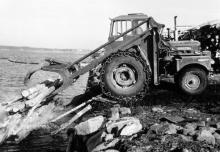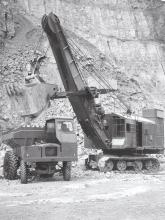
Hydraulics lie at the heart of almost every item of modern construction equipment but these hi-tech reliable circuits were originally pioneered for military machines. Mike Woof reports
In engineering terms, nothing gives progress a shot in the arm as effectively as a war. Throughout the 20th and 21st centuries, new technologies have been developed initially for military applications, with the advanced knowledge then filtering through to civilian applications in industry.
A good example of this is the hydraulic circuit, on which so many heavy pieces of mobile and fixed equipment now rely.
Prior to WWII, hydraulic systems were leaky and unreliable and although some manufacturers had tried to use hydraulic cylinders in their off-highway machines to raise dozer blades for example, the results had left a lot to be desired.
The majority of off-highway machines used in construction and extraction applications relied on mechanical transmission of power, with cableoperated excavators, shovels and draglines dominating the excavation sector. For bulldozers, the cable-raised blade was simple, reliable and durable and the system was also versatile as it could be reconfigured to operate a winch, rippers, scraper bowls or other tools.
Some noted pioneers of the offhighway equipment sector - RG LeTourneau in particular - were so unimpressed with the performance of hydraulic systems that they refused to use them on machines they designed. Instead LeTourneau used only electric and mechanical actuation on his highly innovative machines for many years.
For hydraulics, much of the advancement in technology came from systems developed initially for the aviation sector. The hydraulic systems that operated the control surfaces and undercarriage of military aircraft had to be reliable. It was a matter of life and death. Progress was quick in the countries leading the field in new aircraft design: Germany, Italy, Japan, the UK and the US.
New hydraulic seal systems were the key and ensured that high pressure hydraulic circuits could be relied upon to retain sufficient fluid to work as reliably at the end of a long combat mission, as they were at the beginning.
It is worth noting that even some successful aircraft from the early part of WWII, such as the sturdy Grumman F4 Wildcat ship-borne fighter, still retained a hand-cranked undercarriage. Turning a handle in the cockpit raised or lowered the undercarriage through a complex array of bicycle chains and sprockets. The pilot would have to carry out this strenuous task even at the end of a mission, possibly when injured and contending with a crosswind while trying to maintain height in a damaged aircraft before landing on a small carrier deck that could be heaving up and down by 10m. The F4's replacement, the F6 Hellcat, had hydraulic undercarriage.
Prior to WWII, the use of hydraulic systems in off-highway machines was still the exception rather than the rule. After WWII, a new generation of off-highway machines were quickly developed, in the US in particular, and hydraulic systems dominated. The new wheeled loaders appearing on the market used hydraulic lifting of the loader arms and tipping of the buckets, while the first articulated wheeled loader appeared in 1953.
The Italian Bruneri brothers, widely credited with developing the hydraulic excavator, first unveiled their prototype just a few years after WWII ended. And they even based their prototype on an exmilitary chassis.
Hydraulics became widely used in the off-highway equipment sector across a huge array of different machine classes for tasks such as raising scraper bowls, operator dozer blades and providing tipping functions on haul trucks. By the early 1960s even LeTourneau was forced to admit that hydraulic transmission of power was the way forward.










